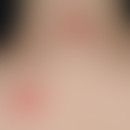Synonym(s)
HistoryThis section has been translated automatically.
Vidal 1886; Toyama 1906
DefinitionThis section has been translated automatically.
Rare, etiologically unexplained, chronic, aphlegmatic dermatosis characterized by ideally round, sparsely infiltrated, frequently solitary, more rarely confluent ichthyosiform plaques. The clinical picture was first described in Japan under the name "pityriasis circinata". A familial cluster has been described.
You might also be interested in
ClassificationThis section has been translated automatically.
Type I: Colored and Asian patients. Number of foci <30; no familial clustering. Association with malignancy in 1/3 of cases (e.g., acute myeloid leukemia).
Type II: Caucasian patients. Number of foci >30; occasionally familial cluster. No associated malignancies (Lefkowitz EG et al. 2016).
Occurrence/EpidemiologyThis section has been translated automatically.
w:m=3:1; several hundred patients have been described worldwide (Al-Refu et al. 2018).
EtiopathogenesisThis section has been translated automatically.
Unknown; likely "pseudoichthyosis." PR primarily affects young adults of African descent and has no gender preference. It also occurs in the Asian population.
ManifestationThis section has been translated automatically.
Ages 9 to 38; PR primarily affects young adults of African descent and has no gender preference. It also occurs in the Asian population.
LocalizationThis section has been translated automatically.
ClinicThis section has been translated automatically.
Occurring singly or in groups, more rarely disseminated, 3-10cm to a maximum of 20cm in size, perfectly round or oval, but also coalescing into circular figures, brown to brown-black, sharply circumscribed, dry scaling, otherwise asymptomatic, only slightly raised plaques. No itching.
HistologyThis section has been translated automatically.
Little specific image.
Discrete changes of the surface epithelium with moderate ortho-hyperkeratosis and follicular hyperkeratosis. No formation of a keratohyalin layer.
Immunohistology: Decrease of fillagrin and loricrin expression in lesional epidermis (= indication of disturbance of keratinocyte differentiation).
Differential diagnosisThis section has been translated automatically.
Pityriasis versicolor: mutiple small focal brownish plaques, often also light spots (pityriasis versicolor alba), fungal detection easily possible.
Pityriasis rosea: exanthematous, inflammatory, small focal plaques with typical scaling
Nummular dermatitis: derb infiltrated, itching, scaly, possibly weeping. Subacute disease.
Erythrasma: intertriginous, disc-like, brownish, positive intrinsic fluorescence.
Fixed drug reaction: acute inflammatory plaque resembling an erythema multiforme, possibly blistering.
TherapyThis section has been translated automatically.
Bland, greasy externals (e.g. Linola Fett, Asche Basis Creme, Linola Fett N Ölbad). Lactic acid-containing externs are preferred.
Progression/forecastThis section has been translated automatically.
Sometimes self-limited course after months. But also chronic course over years possible; improvement in summer.
Remark. An increased incidence of carcinoma and lymphoma has been reported. An association with acute myeloid leukemia has been described (Suzuki Y et al. 2018).
Case report(s)This section has been translated automatically.
The 38-year-old African American woman with a history of hyperprolactinemia, has been treated with cabergoline for 7 months. For 9 months, she noticed sharply outlined, circumscribed hyperpigmented plaques with ichthyosiform aspect. These plaques had a diameter of 3 to 15 cm. (see Fig.). The first lesions appeared on the chest and then gradually increased in size and number. The abdomen, buttocks, and upper and lower extremities were affected. The patient did not report any accompanying symptoms, especially pruritus.
Histopathological examination revealed hyperpigmentation, hyperkeratosis, parakeratosis, flattening of the str. granulosum with flattening of the papillary body; mild perivascular lymphocytic infiltrate.
LiteratureThis section has been translated automatically.
- Aguilera Maruri et al (1968) Le pityriasis circiné et marginé de Vidal, Maladie autonome. Annal de Dermatol Syphilogr (Paris) 95: 49-57.
- Al-Refu et al (2018). Pityriasis rotunda. A clinical study in Jordan: experience of 10 years. International journal of dermatology 57: 759-762.
- Dell'antonia M et al. (2022) Non-familial paraneoplastic pityriasis rotunda associated with chronic lymphocytic leukemia in a Sardinian patient. Ital J Dermatol Venerol 157:375-376
- Grimalt R et al (1994) Pityriasis rotunda: report of a familial occurrence and review of the literature. J Am Acad Dermatol 31: 866.
- Hashimoto Y et al (2003) Immunohistochemical characterization of a Japanese case in pityriasis rotunda. Br J Dermatol 149: 196-198
- Lefkowitz EG et al (2016) Pityriasis rotunda: A Case Report of Familial Disease in an American-Born Black Patient. Case Rep Dermatol 18:71-74.
- Pinos-Leóna L et al (2016) Pityriasis rotunda and hyperprolactinemia. Actas sifiligraphicas 107: 535-537.
- Riley CA et al (2023) Pityriasis Rotunda. 2022 Sep 12. In: StatPearls [Internet]. Treasure Island (FL): StatPearls Publishing PMID: 29083817.
- Rubin MG et al (1986) Pityriasis rotunda: two cases in black americans. J Am Acad Dermatol 14: 74-7.
- Suzuki Y et al (20189 Pityriasis rotunda associated with acute myeloid leukemia. J Dermatol 45:105-106.
- Toyama T (1913) On a hitherto undescribed dermatosis: pityriasis circinata. Arch Dermatol Syphiligr 116: 243.
- Toyama T (1906) On a scaly, pigmented, circular skin affection. Jpn Z Derm Urol 6: 2
- Vidal E (1886) Du lichen (lichen, prurigo, strophulus). Ann Dermatol Syphiligr (Paris) 7: 133-154.
Outgoing links (5)
Erythrasma; Fixed drug eruption; Nummular dermatitis; Pityriasis rosea; Pityriasis versicolor (overview);Disclaimer
Please ask your physician for a reliable diagnosis. This website is only meant as a reference.










